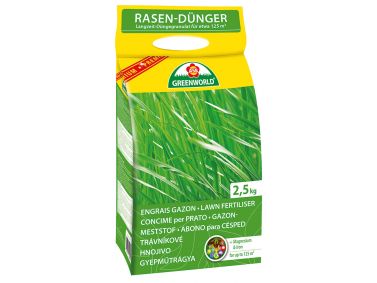
One takes
- High-quality lawn seed mix, adjusted to the intended use (house lawn, sports lawn, lawn in the shade, etc.)
- Lawn soil
- Lawn fertiliser (seasonal fertiliser or long-term fertiliser)
- Rake, flat shovel, or roller
- Watering can. Or hose with watering device and sprinkler
- Lawn mower
Lawn renovation work

Remove died off material. Apply a thin layer of lawn soil to the empty areas and level them.

Sprinkle lawn seeds evenly onto the empty areas. Lightly rake the seeds on the area and tap (or roll) them until they are positioned correctly with the flat shovel.
Water the new seeds carefully with a light sprinkler. Keep the seeds moist until they sprout.

The lawn can be mowed for the first time when it is 6 – 8 cm high.

Ideal time: April and September
Maintenance

Mowing on a regular basis is crucial for a beautiful lawn. Gather the clippings (exception: robotic lawn mower). The more often you mow the lawn, the denser the lawn becomes.

The second most important maintenance measure is the appropriate fertiliser: Depending on the use of the lawn, a long-term fertiliser is applied once in the spring or several times a year, using products that are tailored exactly to meet the required needs.

Autumn fertilisation strengthens the lawn for the winter.

Control of fungal diseases or parasites, if necessary, with the use of appropriate products. Follow the instructions carefully.

Mowing the lawn
The ideal mowing height for a house lawn is 4 – 5 cm. As soon as the grass is 6 – 8 cm high, it is shortened by a third of its total length. Only mower blades that are sharpened well result in a clean cut.
Irrigation
Well-established lawns only need to be watered if there is a persistent drought. If the grass no longer straightens itself after being walked on, it needs water. 15 – 20 mm (= 15 – 20 l/m²) is the ideal amount, and lasts for little over a week.
Weeds
Weeds especially grow in places where there are gaps in the lawn. Weeds have little chance to survive on well-kept lawns.
Recommendations


ASB Greenworld Premium Lawn Top Dressing, 40 L
Designed especially for sowing new lawns or for lawn repair. Ready to use. With sand for better …
ASB Greenworld Premium Lawn Vital Cure, 2,5 kg
Special fertilizer for 100 m² moss-covered and stressed lawns, NK 14-7 (+9% Fe). Special …
ASB Greenworld Premium Lawn Fertilizer, 2,5 kg
NPK 20-5-8 (+4% MgO + 1% Fe) With quick-action and slow-releas Turns your lawn green and strong. …






